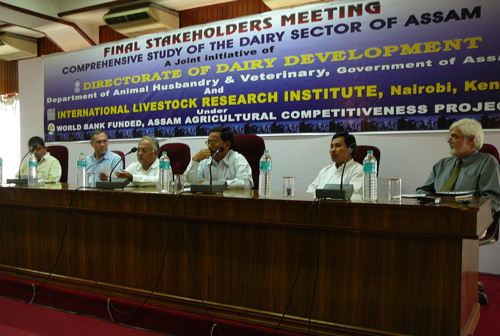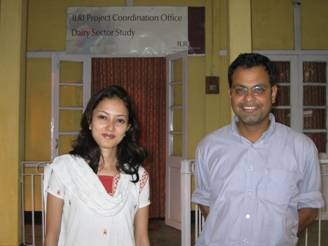300 million poor people in Asia depend on livestock. ILRI's regional representative in Asia outlines the challenges and opportunities and provides an overview of some of ILRI's current activities
Iain Wright took over the post of ILRI’s regional representative in Asia in October 2006, based in ILRI’s office in New Delhi, India. ‘The geographical scope of ILRI’s operations has expanded, especially in Asia and particularly South Asia. There are several reasons behind ILRI’s increasing presence in Asia, and its focus on South Asia, explains Wright. ‘Notably, Asia is home to almost half of the world’s poor livestock keepers, with about two-thirds of those in South Asia.’

Iain Wright, ILRI’s regional representative in Asia
Asia: Historic progress, but progress uneven
Asia is undergoing a phenomenal transformation with some countries progressing at an unprecedented rate – yet many countries and provinces are being left behind.
According to the Millennium Development Goals (MDG) latest indicators, South Asia is home to 47% of the world's poor living on less than $1 a day. India has reduced its poverty rate by 5-10% since 1990; most other countries registered reductions in poverty over the period, except for Pakistan, where poverty has stagnated at around 33% (using national poverty lines). Source: www.developmentgoals.org
|
What is the real extent of poverty in Asia?
A special chapter, which focused on poverty estimates and measures, contained in an Asian Development Bank (ADB) report, considered the real extent of poverty in Asia. ‘Despite experiencing impressive reductions in poverty, Asia region remains host to unacceptably high levels of poverty. There is considerable diversity across Asia and the Pacific in both poverty incidence and poverty reduction trends. For example, while in 2002 around 233 million fewer people lived in poverty than in 1990, a large majority of this reduction is explained by dramatic poverty reductions in the People’s Republic of China, with Southeast Asia also contributing significantly. In comparison, progress was much slower in South Asia, where around 434 million people were still poor in 2002—a figure only some 14 million lower than in 1990.’ The rural poor and South Asia most vulnerable Source: Key Indicators 2004: Poverty in Asia: Measurement, Estimates, and Prospects http://www.adb.org/Documents/Books/Key_Indicators/2004/pdf/Special-Chapter-2004.pdf |
Millions of rural poor in Asia dependent on livestock
‘Despite high levels of economic growth and rising demand for livestock products there are still large numbers of rural poor in Asia who depend to a greater or less extent on livestock for their livelihoods. The challenge is to ensure that they have the means to access markets and the ability to produce products in the quantity and of the quality required.’ says Wright.
Population growth, urbanisation, increasing incomes, and changes in diet preferences are creating a massive growth in demand for animal products, with rapid growth in total milk and meat production, especially pork and poultry. However, these trends have resulted in the following:
• Greater pressure on the natural resource base
• Intensification of animal systems
• Need for improved efficiency in use of feed resources
• Higher concentration of animals in urban and peri-urban areas
• Increased disease risk, pollution and human health issues
Against this backdrop, poor farmers face a diverse set of animal production problems caused by disease, inadequate nutrition, resource degradation and a changing trade and policy environment.
Highlights of ILRI research in Asia
ILRI is currently active in Bangladesh, Cambodia, China, India, Indonesia, Laos, Malaysia, Pakistan, the Philippines, Sri Lanka, Thailand and Vietnam.
Indonesia is one of the world’s poorest countries and has the world’s biggest avian influenza problem. ILRI and partners are pioneering a new community approach, known as ‘participatory epidemiology’, and enlisting villagers help in controlling bird flu in Indonesia through local knowledge.
India has made remarkable progress in poverty reduction. Here, livestock production is growing faster than arable agriculture. It is predicted that livestock will contribute more than half of the total agricultural output in the next 25–30 years. One of the biggest impediments to growth of the livestock sector in India is the large-scale prevalence of Foot and Mouth Disease (FMD). ILRI and partners have recently formulated a global ‘roadmap’ for controlling FMD focusing on the special research needs of the poor in endemic FMD settings.
ILRI is also working in North East India with the Directorate of Dairy Development (DDD) of the Government of Assam, undertaking a comprehensive study to identify opportunities to boost the milk sector and improve the livelihoods of smallholder producers. A new strategy for pro-poor dairy development in Assam has been prepared and the Action Plan will be released shortly.
China has recorded extraordinary poverty reductions over the last two decades, with over 400 million fewer people living in extreme poverty. This emerging giant has demonstrated the importance of agricultural and rural development in poverty reduction. It has also been praised for its potential to become the world’s next science superpower. ILRI has established a molecular genetics laboratory with the Chinese Academy of Sciences (CAAS) in Beijing. The joint CAAS/ILRI molecular genetics laboratory focuses on characterization of the huge wealth of livestock and forage genetic resources in the country as well as providing a focal point for training scientists from throughout Asia in modern genetic techniques.
CAAS ILRI Beijing Lab brief
Important lessons to be learned from Asia
Wright believes that there are many important lessons to be learned from Asian countries’ experiences: ‘By studying the rapidly changing economies of South East Asia and the way in which livestock both contribute to, and livestock keepers benefit from the economic growth, lessons can be learned for the livestock sectors in South Asia and Africa.’
‘There are both positive and negative lessons. On the one hand, some countries, such as China, have made massive strides in poverty reduction, including among rural livestock keepers, but on the other hand, intensification of parts of the livestock sector has resulted in massive environmental problems. Livestock research and development in other parts of the world can learn a lot from analyzing these changes.
ILRI is facilitating an e-consultation for the development of an Action Plan for Pro-Poor Livestock Research for Sustainable Development in South Asia and South East Asia.
‘There is concern that much past livestock research has not contributed to poverty reduction in many parts of Asia. We are encouraging stakeholders from all areas of livestock research and development to get involved in the forthcoming e-consultation.
‘Now is the time to take a fresh look at how livestock research can contribute to poverty reduction in Asia’ concludes Wright.
Further information:
ILRI Research in South East Asia: ILRI’s collaborative projects in South East Asia are summarized in a brief.
ILRI and Livestock Research in South East Asia brief.
ILRI’s representative in Asia: Iain Wright, whose background is in livestock systems, joined ILRI from the Macaulay Institute, Aberdeen, UK, where he worked for 25 years, managing a number of research programmes, and more recently was Head of Business Development and Chief Executive of the Macaulay Institute’s commercial research and consultancy company. Although based in the UK, he worked extensively on livestock research and development projects in Asia.


